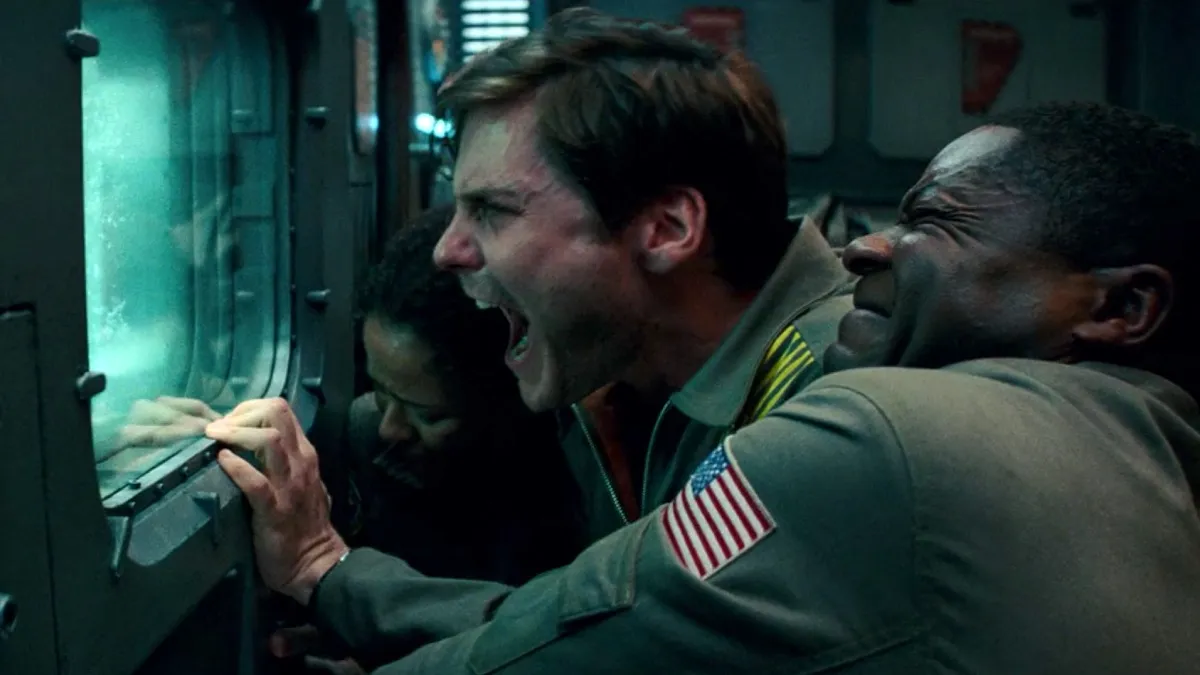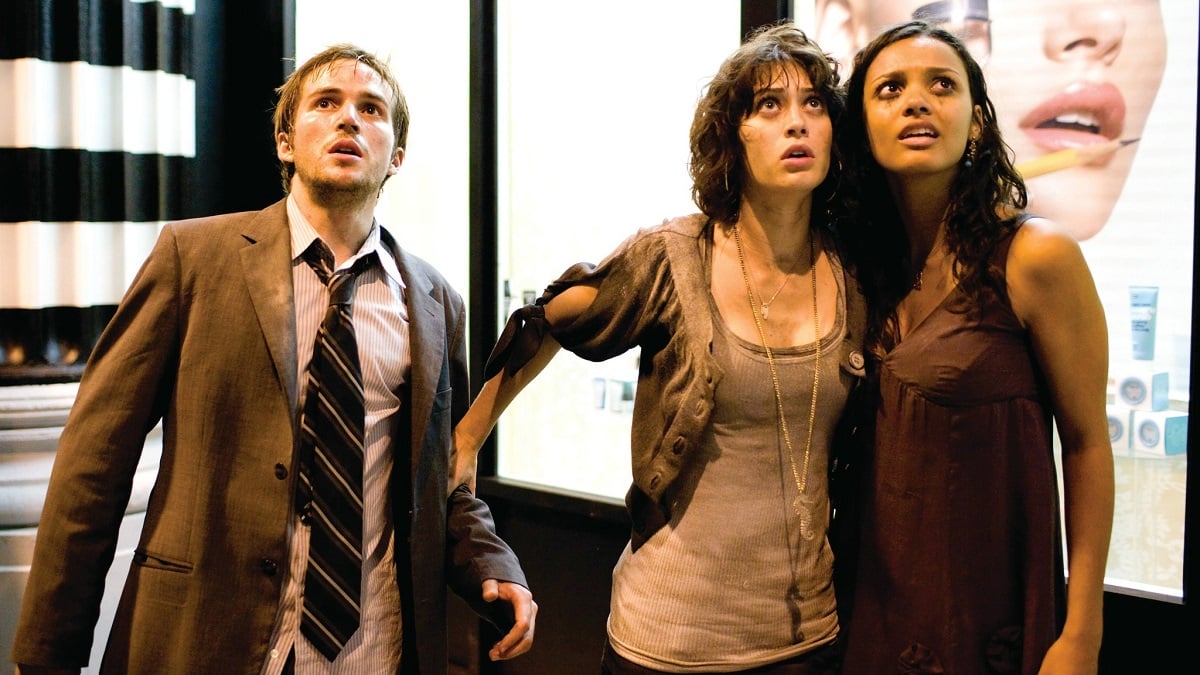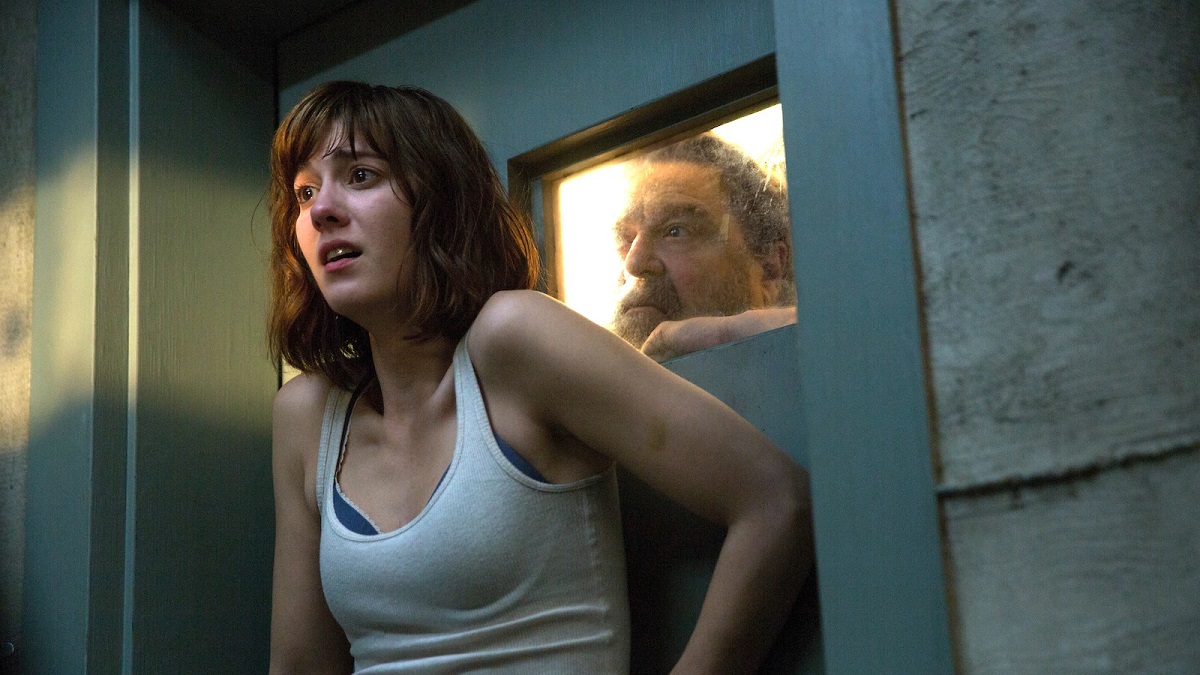Aliens, monsters, survivors, and paranoia: the Cloverfield franchise contains elements closely associated with all of these terms. With stories set years apart and consisting of different ensembles and characters and featuring distinct subplots, it’s somewhat difficult to determine and put a timestamp on the Cloverfield movies. The franchise began with Matt Reeves’ found-footage thriller Cloverfield (2008). In his second directorial venture, Reeves delivered an incredibly unique and strategically styled thriller disguised under a monster movie. With other names like Drew Goddard and J.J. Abrams attached to the project, the film ended on a cliffhanger that laid the perfect groundwork for a sequel.
However, it wasn’t until eight years later that the name ‘Cloverfield’ made the news. 10 Cloverfield Lane (2016), the title, confirmed a connection, sharing the same name as the original film. However, the film marked itself as a standalone sequel, nuanced by a similar sense of suspense and surprise as the 2008 film. While there wasn’t a confirmed sequel to the series until 10 Cloverfield Lane, the franchise formed a trilogy with the Netflix original, The Cloverfield Paradox (2018). That emphasized a need for a chronology of the events across the three storylines.
The Cloverfield series has a unique connection that extends the basic definition of cinematic universes and continuities. And despite the subtle references, there is much to uncover and much more left to viewers’ interpretations. Yet, the intrigue and mystery keep leveling up with each movie, sending fans into wrapt discussions over its mythos.
We, for once, are here to settle the timeline in an orderly fashion.
Cloverfield films in order of release
The three films are set in three distinct, unknown periods. Released across a timespan of 10 years, all three films, when viewed in order of release date, contain several callbacks, theories, and interpretations — thus establishing the connections they share. Here is the release order:
- Cloverfield – January 2008
- 10 Cloverfield Lane – March 2016
- The Cloverfield Paradox – February 2018
However, to fully understand what the Cloverfield monster connection and the alien horror it entails, you have to view the three films in an orderly fashion that clears up the continuity at best.
How to watch Cloverfield films chronologically
The Cloverfield films are neither direct sequels nor prequels to any particular entry in the trilogy. The three films are only connected by their essence and an unexplainable entity that wreaks havoc in all three stories. But, this particular order of viewing clears up the link the three films share at their best. It offers a fantastical yet fictionally explainable logic to the extraterrestrial threats that lurk over the franchise. The chronological order is as follows:
- The Cloverfield Paradox
- Cloverfield
- 10 Cloverfield Lane
The chronology cleverly places The Cloverfield Paradox at the top of the viewing order. However, interestingly, the film is set furthest in the future in the year 2028. But The Cloverfield Paradox offers a dive into a science-fiction-esque explanation of the events in the three films.
The Cloverfield Paradox

Earth is on the brink of destruction due to an ever-escalating energy crisis. A team of astronauts from different nations, with distinct areas of expertise, is sent to space to fire a particle accelerator, a thousand times more powerful than any ever built, to produce free new energy. However, a conspiracy theorist, Mark Stambler, resists that running the particle accelerator can break the barriers of the space-time continuum. He believes that a working particle accelerator could unleash unprecedented chaos across multiple realities and timelines, leading to a collision of what fiction tells us is called the multiverse.
In that explanation lies the ultimate truth about the three films. Though it is mainly unraveled in conversations and is left to interpretation, it’s the best explanation offered in the franchise. Apparently, the mission in the future unified several timelines and exposed them to an alien threat simultaneously. By doing so, The Cloverfield Paradox explains the monsters’ possible origins. It suggests that the other two films take place in different universes, meaning the mission sent the aliens to two different Earths (maybe more) in 2008 and 2016, respectively, thus putting all three films in individual realities while maintaining a common cosmic connection.
It works exactly the same way as Spider-Man: Into the Spiderverse. A machine causes multiple realities and their particles to interact, leading to inter-dimensional travel. The Cloverfield Paradox comes first in the chronology because it is the only film that establishes a connection with the other two. The first two films in the franchise acted as standalone entries. Still, the third one, owing to its name, Paradox, brings everything full-circle.
Some theories suggest that The Cloverfield Paradox merely enables monsters to travel back in time within the same reality and threaten two different periods. Still, the film will automatically become the first in chronology. Of course, viewing the first two films will provide a more comprehensive context into science-heavy The Cloverfield Paradox; the film effectively triggers the events in Cloverfield and 10 Cloverfield Lane.
Cloverfield

The one that started it all, the unexplainable horror-thriller Cloverfield, became famous for giving the genre a fresh story to stand upon. Shot in a found-footage style, the film limited the account to a point-of-view of a few Manhattan residents. It mainly focused on emphasizing the growing intensity of fear, unpredictability, and lack of knowledge rather than diving into the crux of it. There was no subplot besides the one at play, and the movie’s cinematography was on point per the screenplay. And while Cloverfield, unlike The Cloverfield Paradox, doesn’t explain anything, the idea of not knowing works best for it, making it the best entry of the three.
Per what’s revealed in The Cloverfield Paradox, the events in Cloverfield may have been instigated due to the accelerator featured in the former. Apparently, Cloverfield exists in an alternate dimension. There is no direct connection between Cloverfield and the other two films but just the alien monster, which differs vastly in shape, biology, and size, and the fact that the primary threat here is alien and not something else at play by the side.
But throughout the trilogy, Cloverfield deserves credit for helping give the franchise a new perspective toward interconnected storylines and film continuity narratives. Unlike the other two entries in the trilogy, Cloverfield doesn’t require much inclination toward detail; instead, it actively catches the eye through the suspenseful environment it creates around an epic disaster.
10 Cloverfield Lane

Cloverfield is a disaster film. The Cloverfield Paradox is a science-fiction thriller. 10 Cloverfield Lane is psychological horror. Guess the specialty of Cloverfield lies in the tagline this movie carries — “Monsters Come In Many Forms,” says 10 Cloverfield Lane’s poster. And while the monsters in all three films come in distinct forms, obvious, disguised mythos bind the three films together.
10 Cloverfield Lane follows Michelle, who finds herself brought to a small shelter after she is knocked unconscious in an accident. The shelter’s owner, conspiracy theorist Howard Stambler, refuses to let Michelle and Emmett (the third resident in the shelter) go out as he claims an ‘attack of some kind’ has rendered the air above unbreathable. What follows further is three people struggling with an inconfigurable sense of danger and psychological disdain.
10 Cloverfield Lane forms some connections to The Cloverfield Paradox. For instance, the two conspiracy theorists in the films share the same surname — Stambler — although neither film mentions the two having any relation. However, given there is a multiverse, it’s possible that the two Stamblers are different versions, or say, ‘variants,’ of the same person. Also, both films feature a pre-built shelter to escape disastrous events, making them closer to each other than Cloverfield.
But watching the film at the end of the chronology will help viewers build their perspective around the franchise. That is, the name ‘Cloverfield’ carries an essence of a ‘monstrous threat’ that eventually culminates into an ‘alien takeover.’ After Cloverfield, 10 Cloverfield Lane tried to build a symbolic and spiritual continuation to the narrative. And ultimately, The Cloverfield Paradox re-unifies everything and gives it a more thorough understanding.
10 Cloverfield Lane is a claustrophobic drama that uses great performances to lift up its script and present a well-crafted thriller within the dynamics of the original movie.
Like Cloverfield, despite having connections to the third movie, 10 Cloverfield Lane also exists in an alternate reality. It’s a chain reaction, where The Cloverfield Paradox’s experiment starts across timelines, leading to an unexplainable collision of alien life with humans in all dimensions. The science here is bizarre and still poses a ton of questions. And the biggest one is about the origins of the monster aliens. In none of the three films are the monsters explicitly called aliens. They are often hinted, though vaguely, to be part of experiments conducted on Earth. Is it possible they are not aliens but just the results of an experiment that went out of hand? Who is to say for sure?
The three films are based on three unrelated spec scripts and are not intended to be direct sequels or prequels. Instead, neither is marketed as a continuation of the other but only a follow-up.










Published: Apr 13, 2023 04:12 am